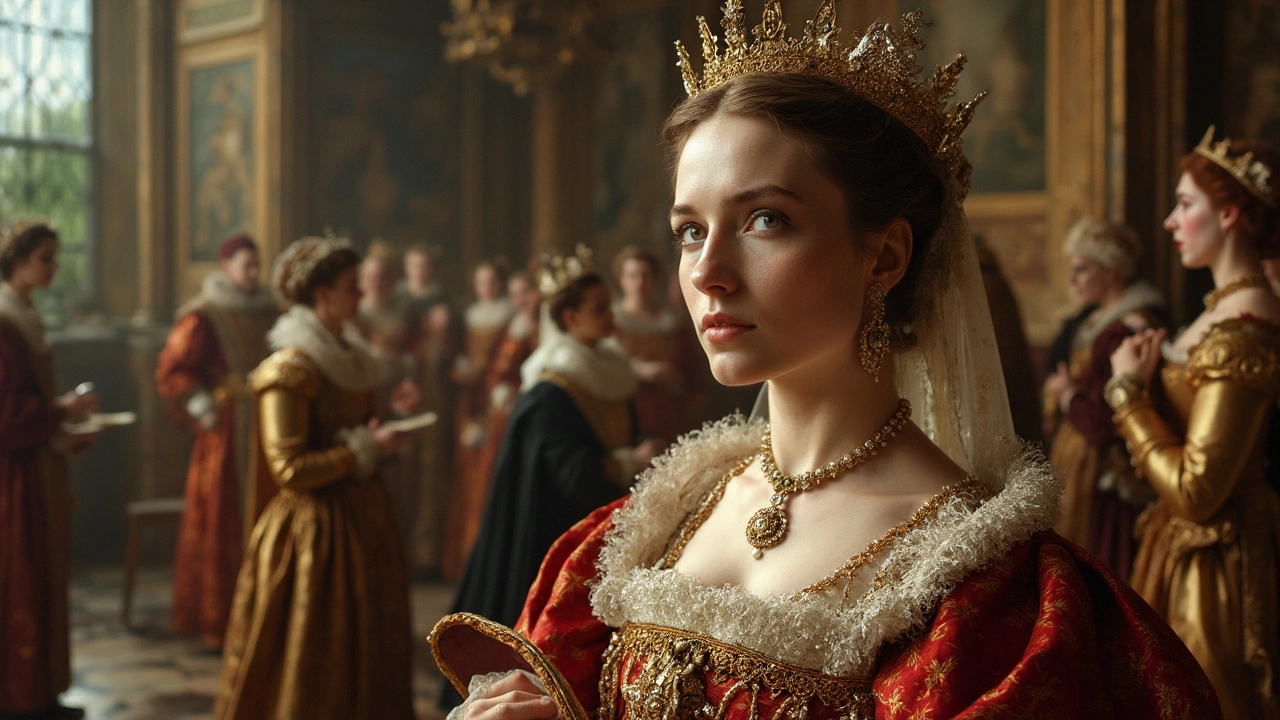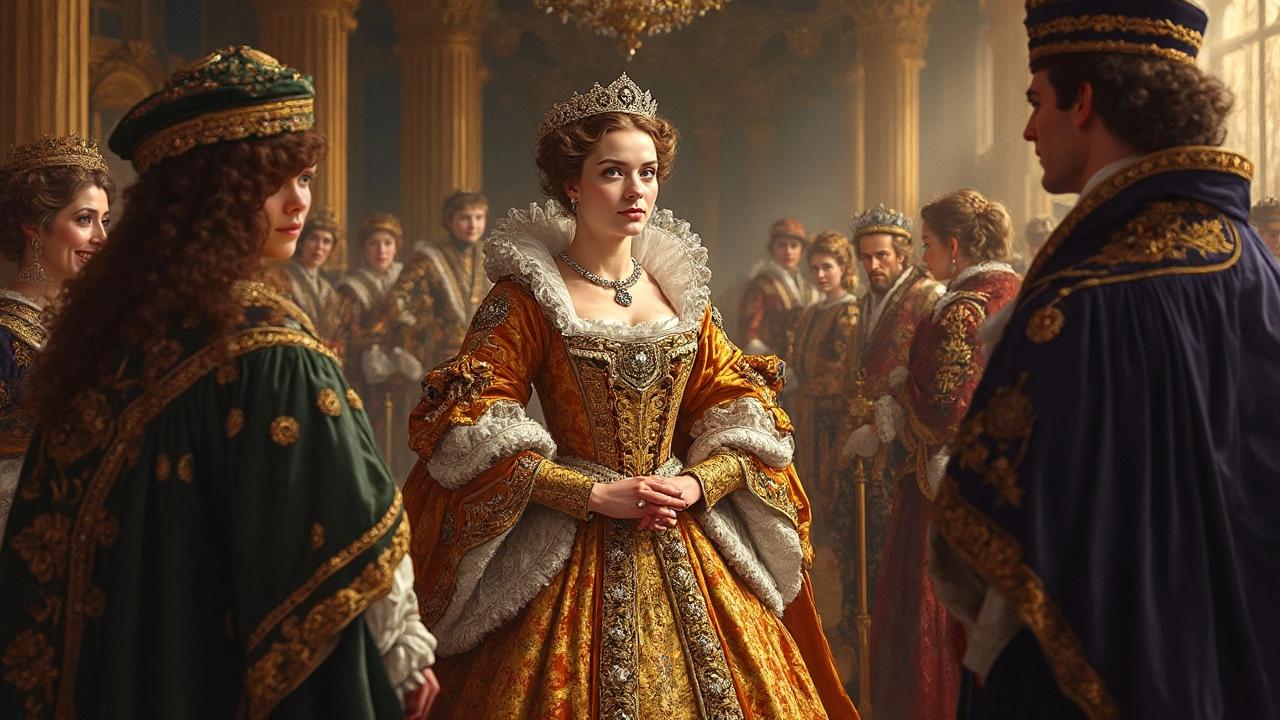
Ever wonder why Queen Elizabeth I dressed the way she did? It wasn't just about wearing nice clothes or keeping up with trends. Elizabeth's clothing choices were a power move, and each garment was a piece of her political puzzle. Think of her wardrobe as her secret weapon—each outfit chosen with care to project strength, stability, and supreme authority.
Take a look at her iconic ruff collars. They might look uncomfortable and strange to our modern eyes, but back then, they were all the rage. More importantly, those collars showed she was untouchable, literally. They created a visual reminder that Elizabeth wasn’t just any royal; she was the Queen. Her clothing choices went beyond fashion statements—they were political tools that helped her navigate a male-dominated world and left a mark big enough to influence the style we see on historical dramas today.
Queen Elizabeth I's wardrobe was more than just a collection of fancy dresses; it was a calculated display of power and influence. Each garment, stitch, and accessory was a testament to her undeniable control and authority. These clothes weren't just for keeping warm—they were statements of her reign.
Take the iconic images of the Virgin Queen in her elaborate gowns, for instance. The fabrics were often imported and exotic; we're talking silks and velvets from places you needed a map for back then. This wasn't just about looking good. It was about showing everyone, at home and abroad, that England was a force to be reckoned with, capable of affording the finest materials.
Elizabeth often wore gowns embroidered with pearls and gemstones. Pearls were particularly significant, symbolizing her purity and wisdom. Fancy rocks weren't the only statement-makers; her use of color was just as bold. Her preference for rich colors like crimson and gold wasn't just about style—it was about status. These dyes weren't cheap, and wearing them screamed wealth and power.
The Queen also had a keen sense of branding before it became a modern concept. The famous 'Ermine Portrait' features her wearing a gown lined with ermine, a fur associated with royalty. This wasn’t coincidental; ermine was reserved for nobility, cementing her high rank visually.
Elizabeth's wardrobe wasn’t just about her personal image, though. It influenced fashion across Europe. Royals and nobility everywhere took note and tried to emulate her style, cementing her influence far beyond her own court.
By making her clothing a symbol of her power, Elizabeth I managed to convey strength and authority at a glance, reminding all who saw her that England was under the rule of a powerful monarch.
When we talk about Queen Elizabeth I's wardrobe, we have to dive into the nitty-gritty of materials and colors. Her clothes weren't just bought off the rack. Oh no, we’re talking about garments crafted from the finest fabrics the world had to offer at the time.
Silk, velvet, and ermine were among her favorite materials. Not only were they luxurious to look at, but they also signified wealth and power. Just imagine walking around in a silk gown during the 16th century—people knew you meant business. If that wasn't enough, her use of pearls reinforced her image even more. Pearls symbolized purity and virginity, two traits she was keen on promoting as the 'Virgin Queen'.
As for colors, Elizabeth had a flair for rich, bold hues. Deep purples, creamy whites, and blood reds featured in her wardrobe often. But here's the kicker—these colors weren’t chosen randomly. They all had a purpose. Purple, for instance, was the color of royalty and nearly impossible to produce, reserved for those with high status. It literally screamed 'I am the monarch.'
Elizabeth also loved gold. Why? Because gold was synonymous with wealth and light. If your outfit shimmered like the sun, you could bet no one would ignore you. The colors weren't just for show; they were strategic choices that sent powerful messages to both her subjects and foreign nations.
In essence, Elizabeth's choice of wardrobe materials and colors was like a visual press release before the press existed. Every gown, every ribbon and jewel told a story about power, purity, and royal dominion.

Queen Elizabeth I was a master of using everything at her disposal, including her wardrobe, to influence politics. Her reign was marked by constant threats, both within England and from abroad. To counter these, her clothing became armor, a statement of power and control that she could project to both allies and enemies.
The elaborate outfits were partially designed to impress foreign dignitaries. If you think about it, clothes were like social media posts are today—a way to send messages without saying a word. When ambassadors came from Spain or France, they didn’t just speak with Elizabeth; they saw her in all her regal splendor, sparkling in pearls and decked in fine fabrics. These weren't just clothes; they were declarations of wealth and stability. To have such riches on full display showed that her reign was solid and thriving.
On the home front, her wardrobe was a tool for managing how her own court saw her. At a time when being female could be seen as a sign of weakness among rulers, her stunning, assertive wardrobe choices declared her as a queen not to be trifled with. By shrouding herself in layers of silk and brocade, she embodied England’s prosperity and her own unquestionable authority. This wasn’t mere vanity; it was strategic genius.
An interesting tidbit? There's a record showing she had new robes made for audiences with parliament—talk about dressing the part!
Queen Elizabeth I may not have known it, but her fashion statements left a lasting mark on modern style. Her love for opulent, extravagant clothing has inspired countless designers and has weaved its way into contemporary fashion movements.
If you’ve ever noticed the occasional ruffled collar making a comeback, you’ve got Elizabeth to thank. The ruff, once a symbol of her authority, regularly pops up on fashion runways, adding a touch of drama and sophistication to modern outfits. Even the dramatic silhouettes of her gowns have inspired avant-garde designers like Vivienne Westwood, who often references historical elements in her collections.
Queen Elizabeth I also pioneered the use of fashion to build a brand identity, something many modern celebrities and influencers have taken to heart. Much like Elizabeth, today’s fashion icons, from Lady Gaga to RuPaul, take full advantage of clothing to create memorable images and reinforce their personal brands.
Elizabeth’s use of colors, especially purple and gold, signals wealth and status and this is still seen today. Fashion powerhouses like Versace frequently incorporate these hues due to their association with luxury and majesty. Even the heavy embellishments and pearls in Elizabeth’s wardrobe have carried their rarity and prestige into present-day fashion design.
| Design Element | Elizabethan Influence |
|---|---|
| Ruffled Collars | Renaissance revival in modern couture |
| Rich Colors | Symbolism of wealth and power |
| Heavy Embellishments | Continuous use in high-end fashion |
In sum, thanks to Queen Elizabeth I, high fashion continues to draw inspiration from the past. Her innovative approach to dressing wasn’t just about beauty, but about making powerful statements. Her taste still reverberates in fashion shows and wardrobes around the globe, transforming how we understand identity and authority through what we wear.
Write a comment